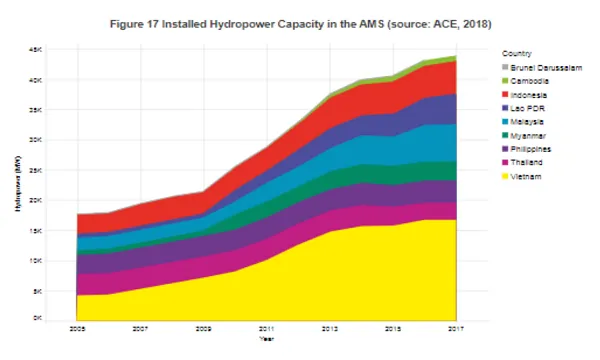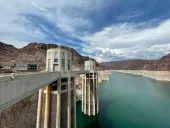
ASEAN's hydropower capacity surged 135.2% to 46GW in 2006-2017
The installed capacities in Malaysia and Vietnam rose to approximately 6GW and 17GW, respectively.
The total installed hydropower capacity in the 10 ASEAN member states (AMS) more than doubled between 2006 and 2017 from 19,839MW to 46,661MW, according to a report published by the ASEAN Centre for Energy (ACE) and Deutsche Gesellschaft für Internationale Zusammenarbeit (GIZ) GmbH.
Data showed that in 2006, Indonesia, the Philippines, Thailand, and Vietnam accounted for about 92% of the total installed hydropower generation in the AMS. Vietnam accounted for 27% of the total capacity (the highest) whilst Indonesia, the Philippines, and Thailand each accounted for slightly below 20%.
In 2017, the installed capacities in Malaysia and Vietnam rose approximately 6,000MW and 17,000MW, respectively. Cambodia, the Lao PDR, and Myanmar increased their installed capacities more than five times due to significant increases in their energy demand, the report’s authors observed.
Along with the installed capacity, the development of energy generation from hydropower in the AMS also accelerated. In 2016, the amount of energy generated increased from 61,563 GWh to 144,533 GWh mainly in Vietnam, the Lao PDR, and Myanmar.
“The rate of increase more than doubled that of the installed hydropower capacity pattern from 2007 to 2017. Technological improvements were the most probable cause because the global efficiency of hydropower was also constantly increasing,” the authors explained. “However, hydropower generation in Indonesia, the Philippines, and Thailand remained constant or slightly decreased.”
The report, which analysed detailed information about the 37 hydropower plants in six AMS, found that of these plants, ten were in the Lao PDR, nine were in Thailand, eight were in Indonesia, five were in Malaysia, nine were in Vietnam, and the other two were located in Myanmar.
The average capacity factor of all the countries was 52%, whilst the median stood at 40%. The maximum capacity factor was 86% whilst the minimum was 27%. Only Indonesia (with the highest average capacity factor at 86%), Malaysia, and Myanmar had average capacity factors higher than the overall average, whereas the other countries had lower average capacity factors, the report noted. The Philippines had the lowest average capacity factor at 27%.

In terms of installation costs, which generally consist of equipment, transformer and interconnecting expenses, hydropower plants were noted to require large amounts of initial investment. The average hydropower installation costs of all the countries was found to be at about $1,793/kW.
“Only Malaysia had average hydropower installation costs above the ASEAN average value based on the collected project data. The cheapest and most expensive installation costs are listed for Thailand and Indonesia at $511 and $3,193/kW, respectively,” the authors added.
A slight difference in the average cost between irrigation and non-irrigation hydropower plants was also expected. “As opposed to the irrigation hydropower plants, the non-irrigation ones are commonly located in more remote locations. Thus, the cost components were higher despite having a bigger energy generation output (Paish, 2002). However, the cost of these projects is on the lower spectrum of the global average range of $1,050 to 8,000/kW,” they highlighted.
The average operating and maintenance (O&M) costs for all of the countries analysed was found to be 1.69% of capex for the plants used for irrigation and 2.15% for the non-irrigation plants. One project in Vietnam was noted to have the lowest O&M percentage (0.94%), whereas another project in Indonesia had the highest O&M percentage (4.08%).
Meanwhile, the levelised cost of electricity (LCOE) for hydropower plants is generally low, although the value is said to be site-specific as different projects calculate their respective capital costs differently. In general, The average of the overall LCOE stood at $0.06/kWh whilst the maximum and minimum were $0.38 and $0.01/kWh, respectively.
Sensitivity analysis also showed that irrespective of whether hydropower plants were irrigation or non-irrigation, the key parameters that had a larger impact on LCOE were capital costs, capacity factor and discount rate.




















 Advertise
Advertise






